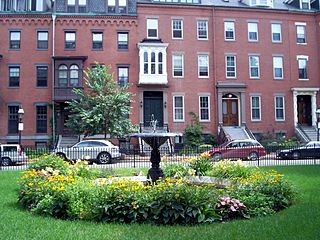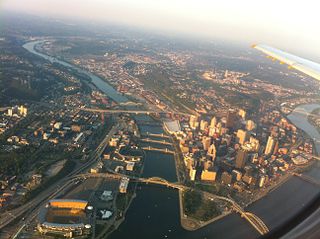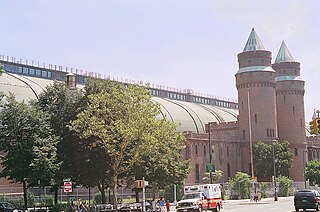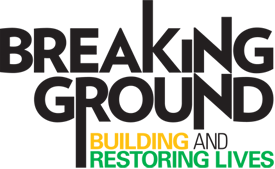
Greenpoint is the northernmost neighborhood in the New York City borough of Brooklyn, in the U.S. state of New York. It is bordered on the southwest by Williamsburg at Bushwick Inlet Park and McCarren Park; on the southeast by the Brooklyn–Queens Expressway and East Williamsburg; on the north by Newtown Creek and the neighborhood of Long Island City in Queens; and on the west by the East River. The neighborhood has a large Polish immigrant and Polish-American community, containing many Polish restaurants, markets, and businesses, and it is often referred to as Little Poland.

The South End is a neighborhood of Boston, Massachusetts. It is bordered by Back Bay, Chinatown, and Roxbury. It is distinguished from other neighborhoods by its Victorian style houses and the many parks in and around the area. The South End is the largest intact Victorian row house district in the country, as it is made up of over 300 acres. Eleven residential parks are contained within the South End. In 1973, the South End was listed in the National Register of Historic Places. Much of the South End was originally marshlands in Boston's South Bay. After being filled in, construction of the neighborhood began in 1849.

East Williamsburg is a name for the area in the northwestern portion of Brooklyn, New York City. East Williamsburg consists roughly of what was the 3rd District of the Village of Williamsburg and what is now called the East Williamsburg In-Place Industrial Park (EWIPIP), bounded by the neighborhoods of Northside and Southside Williamsburg to the west, Greenpoint to the north, Bushwick to the south and southeast, and both Maspeth and Ridgewood in Queens to the east. Much of this area is still referred to as either Bushwick, Williamsburg, or Greenpoint with the term East Williamsburg falling out of use since the 1990s.

The Hill District is a grouping of historically African American neighborhoods in the City of Pittsburgh, Pennsylvania. Beginning in the years leading up to World War I, "the Hill" was the cultural center of black life in the city and a major center of jazz. Despite its cultural and economic vibrancy, in the mid-1950s a substantial area was slated for redevelopment, displacing about 8,000 individuals.

Arthur Christ Agnos is an American politician. He served as the 39th mayor of San Francisco, California from 1988 to 1992 and as the Regional Head of the United States Department of Housing and Urban Development from 1993 to 2001.

Sursum Corda is a small neighborhood located in Washington, D.C., bounded by North Capitol Street on the east, K Street NW to the south, New Jersey Avenue NW to the west, and New York Avenue NW to the north.
Supportive housing is a combination of housing and services intended as a cost-effective way to help people live more stable, productive lives, and is an active "community services and funding" stream across the United States. Supportive housing is widely believed to work well for those who face the most complex challenges—individuals and families confronted with homelessness and who also have very low incomes and/or serious, persistent issues that may include substance use disorders, mental health, HIV/AIDS, chronic illness, diverse disabilities or other serious challenges to stable housing. Supportive housing can be coupled with such social services as job training, life skills training, alcohol and substance use disorder treatment, community support services, and case management to populations in need of assistance. Supportive housing is intended to be a pragmatic solution that helps people have better lives while reducing, to the extent feasible, the overall cost of care. As community housing, supportive housing can be developed as mixed income, scattered site housing not only through the traditional route of low income and building complexes.
Seaton House is the largest homeless shelter in Toronto, Ontario, Canada. It is located at 339 George Street in the Garden District neighbourhood. The facility provides temporary lodging, food, clothing, medical care, for single men and also attempts to provide tools for enabling them to establish their independence. The shelter houses up to 700 men though, in the past, it has exceeded capacity and housed as many as 900 men. It is expected to close in 2020.

The Kingsbridge Armory, also known as the Eighth Regiment Armory, is located on West Kingsbridge Road in the New York City borough of the Bronx. It was built in the 1910s, from a design by the firm of then-state architect Lewis Pilcher to house the New York National Guard's Eighth Coast Defense Command, a regiment-sized unit which relocated from Manhattan in 1917. It is possibly the largest armory in the world.

Breaking Ground, formerly Common Ground, is a nonprofit social services organization in New York City whose goal is to create high-quality permanent and transitional housing for the homeless. Its philosophy holds that supportive housing costs substantially less than homeless shelters — and many times less than jail cells or hospital rooms, and that people with psychiatric and other problems can better manage them once they are permanently housed and provided with services. Since its founding in 1990 by Rosanne Haggerty, the organization has created more than 5,000 units of housing for the homeless. "This is about creating a small town, rather than just a building," according to Haggerty. "It's about a real mixed society, working with many different people." Haggerty left the organization in 2011 to found Community Solutions, Inc. Brenda Rosen was promoted from Director, Housing Operations and Programs to Executive Director, and has led the organization since.

Greenpoint Church is a Reformed Church in America and United Church of Christ church at 136 Milton Street in the Greenpoint neighborhood of Brooklyn, New York. As of March 2012, it had a congregation of 80 people.

Bradford S. Lander is an American politician, urban planner, and activist serving as a member of the New York City Council for the 39th District.
RiseBoro Community Partnership, formerly known as Ridgewood Bushwick Senior Citizens Council, is a non-profit organization in Bushwick, Brooklyn. Founded in 1973 by Vito Lopez, RBSCC offers housing and family services to neighborhoods in Brooklyn and Queens.Ridgewood Bushwick Senior Citizens Council is a non-profit organization in Bushwick, Brooklyn. RBSCC offers housing, youth, healthcare family and senior services to the residents of Bushwick, Williamsburg, Greenpoint, East New York, Ridgewood, Glendale, and surrounding Brooklyn and Queens communities.

The 23rd Regiment Armory, also known as the Bedford Atlantic Armory, the Marcy Avenue Armory, and the Williamsburg Armory, is a historic National Guard armory building located at 1322 Bedford Avenue between Atlantic Avenue and Pacific Street in the Crown Heights neighborhood of Brooklyn, New York City, United States. The building is a brick and stone castle-like structure designed to be reminiscent of medieval military structures in Europe. It was built in 1891–95 and was designed in the Romanesque Revival style by Fowler & Hough, local Brooklyn architects, and Isaac Perry, the New York state government's architect.

The San Francisco Bay Area comprises nine northern California counties and contains four of the ten most expensive counties in the United States. Strong economic growth has created hundreds of thousands of new jobs, but coupled with severe restrictions on building new housing units, it has resulted in an extreme housing shortage which has driven rents to extremely high levels. The Sacramento Bee notes that large cities like San Francisco and Los Angeles both attribute their recent increases in homeless people to the housing shortage, with the result that homelessness in California overall has increased by 15% from 2015 to 2017. In September 2019, the Council of Economic Advisers released a report in which they stated that deregulation of the housing markets would reduce homelessness in some of the most constrained markets by estimates of 54% in San Francisco, 40 percent in Los Angeles, and 38 percent in San Diego, because rents would fall by 55 percent, 41 percent, and 39 percent respectively. In San Francisco, a minimum wage worker would have to work approximately 4.7 full-time jobs to be able to rent a two-bedroom apartment.

George Street is a north–south street in Toronto, Ontario, Canada from south of Front Street, north to Gerrard Street. Its southern blocks are within the grid of the townsite of the original town of York, Upper Canada. George Street was once one of the most exclusive and expensive addresses in the city. Today, the north end of the street, next to Seaton House men's shelter, is an example of urban blight. The City of Toronto government is redeveloping the street with a new Seaton House institution focussed more on long-term care. Several abandoned buildings have been bought by the city and others have been expropriated to facilitate the redevelopment - the George Street Revitalisation Project.
Simon Dushinsky is an American real estate developer who co-owns the New York City-based Rabsky Group with his partner, Isaac Rabinowitz.
The Dorothy Day shelter is a homeless shelter campus in Saint Paul, Minnesota, United States. The project is centered around the site of the Dorothy Day Center built in downtown Saint Paul in 1981. The shelter is named after American Catholic and social activist Dorothy Day. The Dorothy Day Center started as a drop-in center for meals to help the homeless population in downtown Saint Paul. The facility is operated by Catholic Charities of St. Paul and Minneapolis in coordination with Ramsey County, Minnesota.

The 13th Regiment Armory is a historic armory designed by architects Rudolph L. Daus and Fay Kellogg and built in 1892–1894. It is located at 357 Marcus Garvey Boulevard between Putnam and Jefferson Avenues in Bedford-Stuyvesant, Brooklyn, New York City. Daus had previously designed the Lincoln Club on Putnam Avenue in 1889.

Columbus, the capital city of Ohio, has a history of social services to provide for low- and no-income residents. The city has many neighborhoods below the poverty line, and has experienced a rise in homelessness in recent decades. Social services include cash- and housing-related assistance, case management, treatment for mental health and substance abuse, and legal and budget/credit assistance.















